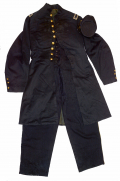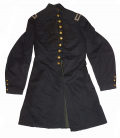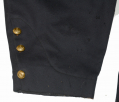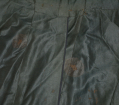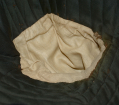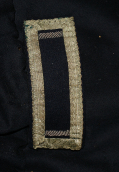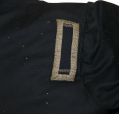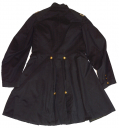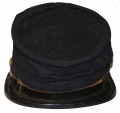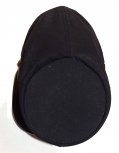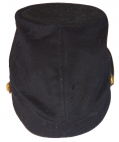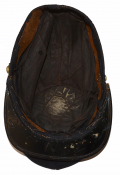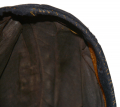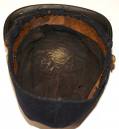site search
online catalog
CONFEDERATE INFANTRY CAPTAIN’S JACKET OF CAPT. HENRY DAVENPORT, 2ND VIRGINIA, STONEWALL BRIGADE; LIKELY WORN TO HANG JOHN BROWN AND FAMOUS CHARGE AT 1ST MANASSAS
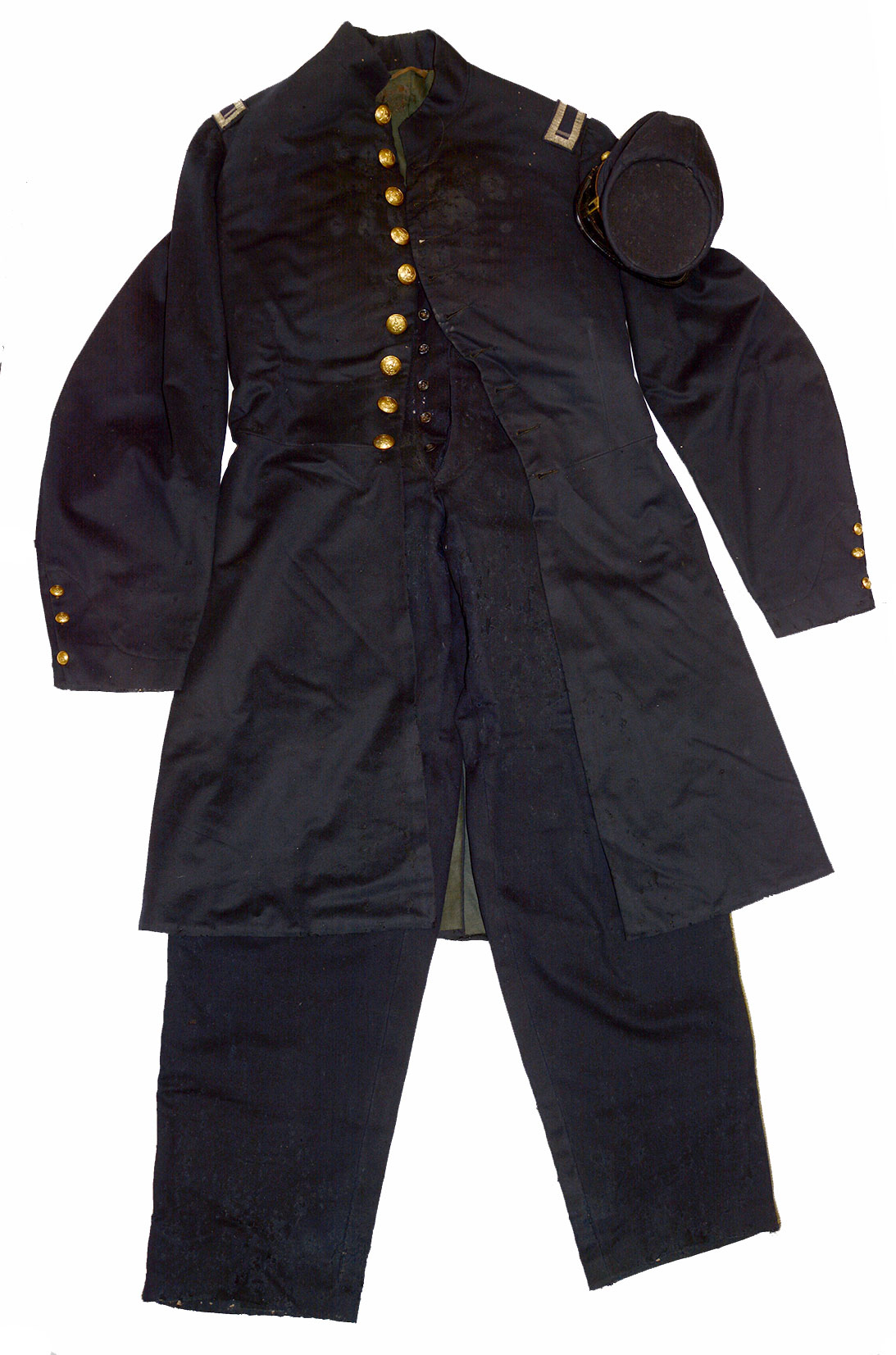
$29,500.00
Originally $37,500.00
Quantity Available: 1
Item Code: 846-548
Shipping: Determined by Method & Location of buyer
To Order:
Call 717-334-0347,
Fax 717-334-5016, or E-mail
This historic Virginia officer’s frock coat, trousers and cap belonged to Lt. Henry Bedinger Davenport of Charlestown, Virginia (1831-1901,) follows the state’s 1858 regulations, and has a tight provenance, having been sold out of the family by a grandniece. Davenport had been commissioned a lieutenant in the Jefferson Guard at its organization in Spring 1858, amid the revitalization of the Virginia militia as sectional tensions in the country rose. Contemporary newspaper accounts record him as one of four officers called out with the company on the morning of October 17, 1859, upon news of trouble at nearby Harpers Ferry. The company was armed and on its way by 10:00 that morning and arrived about 11:30, the first of the Virginia and Maryland militia companies that converged on the town, and were ordered to cross the river to the Maryland side of the river to seal off the bridge. They took part in the rest of the siege as other militia companies arrived later in the day and into the night, along with a detachment of U.S. Marines. After the capture of the raiders the company remained on active duty all the way to March 23, 1860, including guard duty at the trials and executions of Brown and six co-conspirators, while other Virginia militia units came and went in the intervening months. One biographical note states Davenport was in Brown’s personal escort from the jail to the courtroom during his trial and newspapers record detachments from the company as guards in the courtroom at various points during the different trials. At Brown’s execution on December 2, 1859, the company was posted at the front of the jail and thus witnessed him mounting the wagon on his way to the scaffold. They were also present for the executions of Brown’s six captured co-conspirators: four on December 16 and the remaining two on March 16, 1860. Davenport’s father, Braxton Davenport, was the presiding magistrate of the county court at the time of the raid and was the judge who remanded Brown to jail to await trial. The younger Davenport went on to answer Governor Letcher’s call up of the company to seize the U.S. armory at Harpers Ferry in April 1861, serving as a lieutenant in the 2nd Virginia of Jackson’s brigade at First Manassas and seeing further action as the company commander until leaving the service in May 1862. Given the wear of similar blue Virginia militia uniforms based on U.S. regulations by other Confederate troops at First Manassas, including Jackson himself, it is likely Davenport was wearing this at that first great battle of the war, where Jackson earned his nickname.
Davenport’s father was a wealthy farmer, claiming over $136,000 in real estate in the 1860 census, had served in the militia as a lieutenant colonel, and held several public offices, including terms in the state legislature and county Deputy Sheriff, and serving as the presiding magistrate of the county court at the time of Brown’s raid. The younger Davenport also listed himself as a farmer and had typical gentleman’s education by private tutors and a year at the University of Virginia in 1850-51. He took time off between the trials and hangings of Brown and his men to marry Martha Clay, daughter of Brutus J. Clay of Kentucky, in January 1860. The 1860 census, taken in August, has them living with his family in Charlestown, presumably at “Altona,” the Davenport family estate.
Brown’s trial and fate likely caused little tension in the extended family, though secession may have. Davenport’s father-in-law was a prosperous slaveholder, but also a Unionist who served in the U.S. House of Representatives 1863-1865 (though he did follow his own self-interest in voting against the 13th Amendment.) Nevertheless, Davenport answered Gov. Letcher’s call up of the Jefferson Guard for state service on April 17, 1861, ordering it to help seize the Harpers Ferry Armory. They assembled on April 18, took possession of the armory the next day, remained there until June 14 while the state salvaged the arms and arms-making machinery and Jackson took over on May 1, organizing the troops. The company had been part of the 2nd Virginia State Troops and formally mustered into state service for one year on May 13 as Company A of that regiment. The regiment was offered to the Confederate States in early June and accepted into the Provisional Army CSA on July 1, giving Davenport his official date of rank in the Confederate army.
The regiment saw action first on July 5 at Falling Waters or “Hokes Run,” where Jackson staged a fighting withdrawal in the face of two brigades of Robert Patterson’s federal division who crossed the Potomac near Williamsport and headed for Martinsburg. Casualty figures are incomplete, but other regiments in Jackson’s brigade suffered at least 11 killed and 12 wounded. Patterson eventually lost courage withdrew to Harpers Ferry, freeing Johnston’s forces in the Shenandoah to join Beauregard at Manassas. There on July 21 as part of Jackson’s brigade the 2nd Virginia took part in the fighting on Henry Hill, earning Jackson his nickname, but at considerable cost: one report lists 15 killed, 53 wounded and 8 missing for a total of 76; another, 18 killed and 72 wounded, for a total of 90.
One of the casualties was Davenport’s company commander, J.W. Rowan, which placed Davenport in command at least until the end of December 1861. This covers the period when the regiment was posted at Centreville and Fairfax Court House after Bull Run, its transfer with Jackson to the Valley District, the assignment of Garnett to command of the brigade in November, and the expedition to destroy Dam #5 on the Potomac. Exactly when Rowan returned to command of the company is unclear, but they saw some action in the Romney Campaign in January and serious fighting in March at Kernstown, where the regiment lost 6 killed, 33 wounded and 50 missing out of 320 engaged, in one of Jackson’s few defeats. The regiment was in reserve at the Battle of McDowell on May 8, and Davenport seems to have left the regiment on May 18, while they were camped at Mount Solon, about ten miles from Harrisonburg, when his service record lists him as “dropped.” At this point the army was reorganized as one-year enlistments were expiring, and Davenport either chose not to stand for reelection as an officer or was not elected. An 1865 letter to President Andrew Johnson in support of a pardon says that he served until expiration of his term of service, which he says was four-year commission as lieutenant, which may simply mean he resigned from state service after four years. He then resumed farming at the family estate at Charlestown and resided at least part of the next three years with his father-in-law in Kentucky, whom he makes sure to identify as the “Hon. B.J. Clay of Kentucky.” He certainly had a vested interest in returning home to protect the family property. His father died in late 1862; the area fell under U.S. control as part of West Virginia; even more significantly, the house was reputedly used by Sheridan as a headquarters and even visited by Grant. His 1865 oaths of allegiance are to both the U.S. and to the state of West Virginia. The house still stands today, having passed out of family hands only from 1906-1936. Davenport died in 1901. Despite the necessity of yielding to federal and, newly formed, state authority, he remained proud of his Confederate service. His tombstone records his wartime service in the 2nd Virginia and the Stonewall Brigade.
Davenport’s uniform follows the Virginia 1858 regulations, which followed those of the U.S., but with the substitution of Virginia state seal buttons, etc. All the pieces have great color the set comes with a 2021 conservation report from the Varnum Memorial Armory Museum of Rhode Island. The single-breasted blue wool frock coat utilizes 13 coat size Va 7A2 ((Albert) rmdc buttons, comprising 9 on the front and 4 on the rear waist and tails. The cuffs are non-functional, each with 3 cuff buttons, all Va222As6 (Tice) Scovills & Co. Extra. Every indication is that these are all the original buttons. The coat exhibits classic early Civil War period sleeve cut with ballooning elbow tapering to narrow cuff with some billowing at the shoulder. The standup collar rises to 1 1/2" at the back. Quilted breast lining with single breast pocket, lined with brown cotton; the sleeves lined with white polished cotton. The shoulder straps are flat bullion braid with dark blue centers bearing the single narrow bar of a 1st Lieutenant at either end. The coat exhibits scattered small spots of mothing with heavier loss on the wearer’s upper left breast and right lapel. The quilted lining is excellent and the seams are tight.
The dark blue trousers are also classic period form and utilize an 1/8" muted gold bullion covered cord on the seam, showing some wear, but complete. Belted back, watch pocket in waist band, front pockets with button closure at the top corner (buttons missing,) 6 suspender buttons in place, 5 button fly front closure, with a sixth button, inward facing, closing the waist band. Watchpockets of white cotton with 1 ½” waist band lining and 2” hip lining below that a combination of plain and polished white cotton. Trousers exhibit moth damage primarily on the front, all of which has been professionally backed and is not terribly noticeable. As with the coat all seams are tight.
The front of the cap is 3 1/2" tall and has a pronounced, fashionable tilt forward. The flat tarred visor is short and has a bound edge. The glazed chinstrap with stamped brass adjusting buckle and cuff size Virginia staff side buttons is in place. The sweatband is missing but the black polished cotton lining, oxidizing toward brown, including quilted crown, is intact and excellent. Body of the kepi with scattered minor moth damage, more severe at the lower front adjacent to the visor, which has been backed and is not obtrusive.
This is a very significant uniform connected with John Brown’s raid, which arguably lit the fuse for the outbreak of war, and the first great battle of that war, which determined it was not going to be any thirty-day or even one-year affair, and rather confirmed Brown’s own prophecy that not only would the country’s sins only be purged by blood, but that he had “vainly flattered” himself that it might be done “without very much bloodshed.” [sr][ph:L]
~~~~~~~~~~~~~~~~~~~~~~~~~~~~~~~~~~~
THIS ITEM, AS WITH ALL OTHER ITEMS AVAILABLE ON OUR WEB SITE,
MAY BE PURCHASED THROUGH OUR LAYAWAY PROGRAM.
CLICK HERE FOR OUR POLICIES AND TERMS.
THANK YOU!
Inquire About CONFEDERATE INFANTRY CAPTAIN’S JACKET OF CAPT. HENRY DAVENPORT, 2ND VIRGINIA, STONEWALL BRIGADE; LIKELY WORN TO HANG JOHN BROWN AND FAMOUS CHARGE AT 1ST MANASSAS
For inquiries, please email us at [email protected]
Most Popular
Historical Firearms Stolen From The National Civil War Museum In Harrisburg, Pa »
Theft From Gravesite Of Gen. John Reynolds »
Selection Of Unframed Prints By Don Troiani »
Fine Condition Brass Infantry Bugle Insignia »
British Imported, Confederate Used Bayonet »
Scarce New Model 1865 Sharps Still In Percussion Near Factory New »
featured item
WELL-WORN CIVIL WAR BROGANS
Officially known as the M1851 Jefferson Bootee, the simple but rugged “brogan” was the standard issue shoe for both US and CS forces during the Civil War. They have a medium rise upper with four eyelets for laces, a square toe, and pegged sole.… (1268-019). Learn More »



